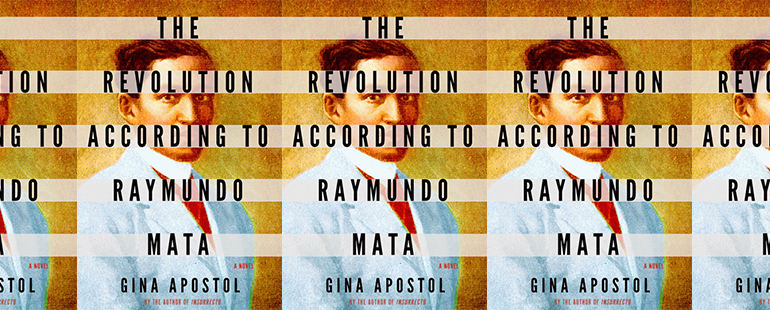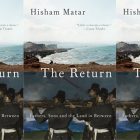The Revolution According to Raymundo Mata by Gina Apostol

The Revolution According to Raymundo Mata
Gina Apostol
Soho Press | January 12, 2021
Gina Apostol’s The Revolution According to Raymundo Mata, which won the Philippine National Book Award, is a story about a story. The book is the fictional memoir of Raymundo Mata, a half-blind, self-professed bookworm who comes from a family of dramatists and publishes political pamphlets. Mata’s memoir explores the transition between the Spanish and American colonial wars in the Philippines, but there’s more. The memoir’s Filipino editor, anonymous translator, and American critic debate the historical accuracy and quality of Mata’s work in the preface, footnotes, and postscript. These complex, interrupting layers produce a hyper metafiction that is playful and ironic like Cervantes’s Don Quixote and satirize social critiques and political violence like Roberto Bolaño’s 2666.
Apostol’s narrative fracturing, perpetuated by external voices that edit, erase, and opine, parallels the violence forced upon the Philippines by foreign powers, the hostile Spanish and American takeovers exasperating its ever-shifting identity. As a result, Mata’s memoir is a pastiche of his life and of national history. It seems no coincidence that Mata writes in Spanish, Tagalog, and English, native tongue celled between colonial linguistic prowess, his authorial voice pushed and pulled between external forces.
While Mata organizes his memoir into a kind of origin story that moves from his birthplace and family to his participation in the resistance, the influence of the historical figure and revolutionary author José Rizal drives the narrative. Once the protagonist reads Rizal’s illicit novel Noli Me Tángere (Touch Me Not) gifted to him by a priest named Pío Valenzuela, he begins his quest to find the national hero. Here, fact and fiction intersect, both Mata and Rizal eventually colliding on the page. As Mata’s translator writes in her introduction to the manuscript, “Our notion of freedom began with fiction, which may explain why it remains an illusion.” Even the translator’s name seems to play with the idea of fiction reflecting a collective imagination and a nation’s disillusion, her surname espejo meaning mirror in Spanish. Apostol writes in her precursory Author’s Note, “two things shape the Filipino: puns and José Rizal,” less a wink to readers and more an invitation to a challenging jigsaw puzzle from the outset.
The manuscript’s three critics reveal that Mata meets with Rizal early on, as they debate the veracity of the meeting. Rizal resides exiled on an island under Spanish watch, and the three resurface this detail in footnotes so many times that when the event does take place, the anticipation has been built up—we want to see for ourselves just what happens between these two revolutionary writers. It’s quite possibly the best sequence of scenes in the novel, history and fiction—represented in Rizal and Mata—threaded so tightly together that they, for a moment, defragment and coalesce as one.
This interweaving recalls the Spanish word historia, which can mean either history or story depending on the context; Apostol writes the Philippines’ nineteenth-century historia by exploiting history in frontmatter, footnotes, and postscripts, and tethering fictionalized historical figures with fictional characters on a single plane. But this game of metafiction comes at a price, the illusion the translator speaks of. When Mata comes face to face with Rizal and, observing how he and others engage the living legend, says, “It’s true. His bones did not matter. We wanted of him what was air and nothing, such as his name, a ghost louse-scratch.” The promise of revolution is fleeting. We know the Philippines won’t win their revolution, but Mata doesn’t know, his memoir a revisited national memory that almost reaches its goal of winning the war, its independence, but never does.
There’s a Sisyphean struggle between this hope and disappointment in the book, and in this struggle, there are no easy answers. Instead, there’s missing fragments, alleged mistranslations and misinterpretations. As we volley between footnotes and source text, opinions and first-hand experience, fact and fiction, it becomes clear that Apostol’s novel requires us to sit up, lean in, and study. It demands our active participation. In the end, The Revolution According to Raymundo Mata is intended for a Filipino audience first— with inside jokes, play on words, and regional references—and American audiences second. And that’s a definitive reason to pick it up. Apostol holds a mirror to American exceptionalism and forces us to look.
The Revolution is a work intended for a Filipino audience first, with inside jokes, plays on words, and regional references, and American audiences second. Apostol holds a mirror to American exceptionalism. It’s a penance academics realize through postcolonial studies like the American critic analyzing Mata’s memoir. The Revolution According to Raymundo Mata, like the effects of the wars, is never really finished—there’s missing fragments, alleged mistranslations, and misinterpretations—and readers may not connect all the puzzle pieces, which just might be the point.



